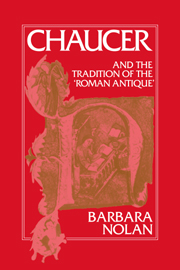Book contents
- Frontmatter
- Contents
- Acknowledgments
- List of abbreviations
- Introduction
- 1 Benoît de Sainte-Maure's Roman de Troie and the compositional practices of the roman antique
- 2 Plaits, debates, and judgments in the Roman de Thèbes, the Roman de Troie and the Roman d'Eneas
- 3 The poetics of fine amor in the French romans antiques
- 4 From history into fiction: Boccaccio's Filostrato and the question of foolish love
- 5 Boccaccio's Teseida and the triumph of Aristotelian virtue
- 6 Saving the poetry: authors, translators, texts, and readers in Chaucer's Book of Troilus and Criseyde
- 7 The consolation of Stoic virtue: Chaucer's Knight's Tale and the tradition of the roman antique
- Epilogue
- Notes
- Bibliography
- Index
3 - The poetics of fine amor in the French romans antiques
Published online by Cambridge University Press: 11 September 2009
- Frontmatter
- Contents
- Acknowledgments
- List of abbreviations
- Introduction
- 1 Benoît de Sainte-Maure's Roman de Troie and the compositional practices of the roman antique
- 2 Plaits, debates, and judgments in the Roman de Thèbes, the Roman de Troie and the Roman d'Eneas
- 3 The poetics of fine amor in the French romans antiques
- 4 From history into fiction: Boccaccio's Filostrato and the question of foolish love
- 5 Boccaccio's Teseida and the triumph of Aristotelian virtue
- 6 Saving the poetry: authors, translators, texts, and readers in Chaucer's Book of Troilus and Criseyde
- 7 The consolation of Stoic virtue: Chaucer's Knight's Tale and the tradition of the roman antique
- Epilogue
- Notes
- Bibliography
- Index
Summary
No one can doubt that the “love interest” in the twelfth-century romans antiques is one of their most important and innovative features. The treatment of erotic love in the Roman d'Eneas and the Roman de Troie sharply distinguishes them from the chansons de geste as well as the lyric cansos of the same period. The Eneas-poet and Benoît de Sainte-Maure were the first medieval vernacular writers to pose urgent, practical questions about the place of sexual love in a highly structured, politically ambitious aristocracy. The French poets' dramatizations of love both enact “un art d'aimer,” as Jean Frappier suggested, and, as I argue in this chapter, explore the ethical significance of private love in relation to public, moral life and historical narrative consequences. Several scholars have described the behavior typical of young lovers in the northern French romances of antiquity, and we are especially indebted to Edmond Faral for demonstrating their dependence on Ovid's love poems.
Yet considerable confusion remains as to the narrative and ethical functions of the love interest in the first extended classicizing fictions en romanz. In what terms and for what purpose does the Eneas-poet distinguish between Eneas' relationship with Dido and his love for Lavine? Does Benoît de Sainte-Maure celebrate fine amor as an independent, positive system of behavior in his Roman de Troie, as Alfred Adler once argued, even as he laments its defeat by militia? Is he principally interested in the psychological plight of characters “caught between love and death, honor and desire”?
- Type
- Chapter
- Information
- Chaucer and the Tradition of the Roman Antique , pp. 75 - 118Publisher: Cambridge University PressPrint publication year: 1992

